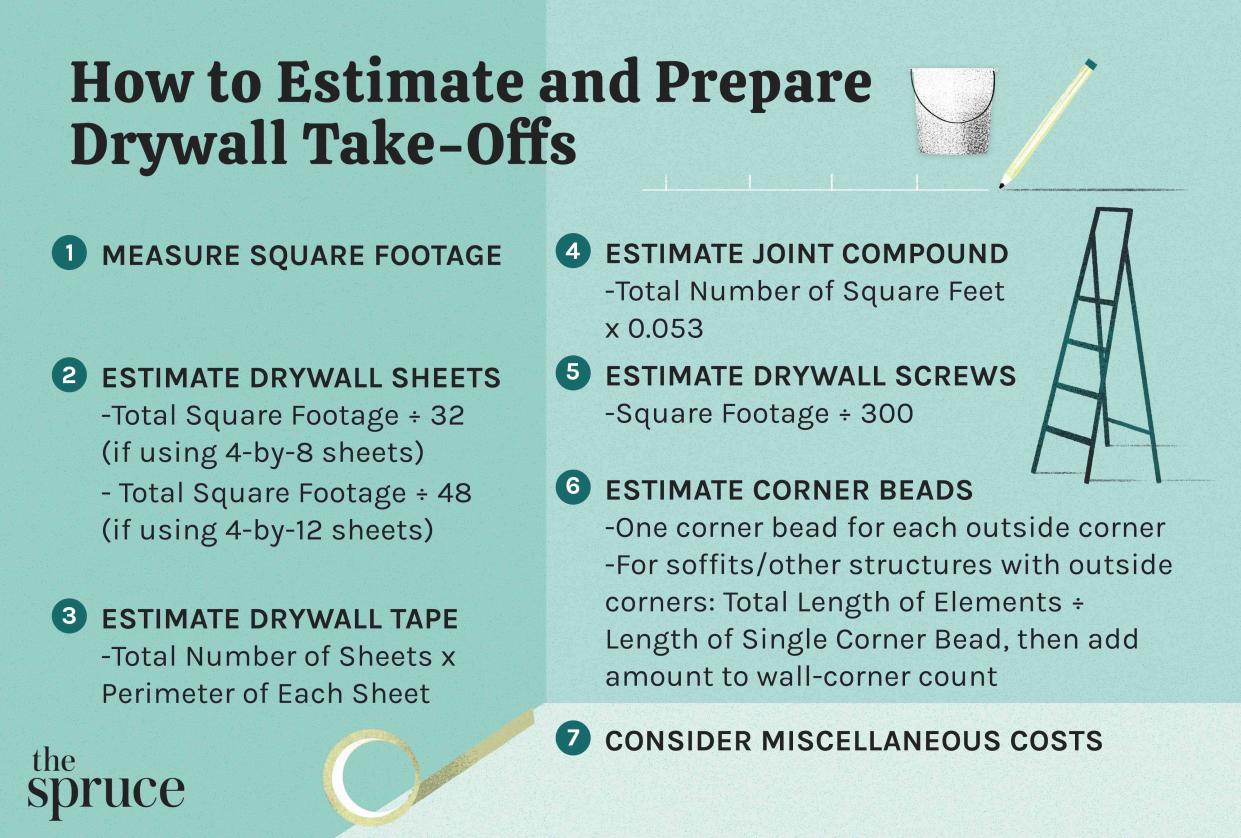How to Estimate and Prepare Drywall Take-Offs

The Spruce / Michela Buttignol
Many contractors have a tough time when estimating and completing take-offs for drywall work, but figuring the amount of drywall and other materials needed for a project is really a simple task. Follow the same steps that professionals and large companies use to count drywall sheets, mud, tape, screws, and corner bead. Once you have an idea of the quantities, you can quickly calculate the total materials cost.
Always add extra to your final estimate as a contingency fund for any unexpected issues: Being prepared to spend more can help manage expectations.
Measure Square Footage
Measure the total square footage of the areas where the drywall will be installed. Multiply the width times the height of each wall or ceiling area, then add all of the quantities together to get a total square-foot amount.
Estimate Drywall Sheets
Calculate how many drywall sheets you will need by dividing the total square footage of area by 32 (if you're using 4-by-8 sheets) or by 48 (if you're using 4-by-12 sheets).
This division will get you the numbers of full sheets required. It's a good idea to add 10 to 15 percent for waste and odd cuts. For example, if your total area is 1,600 square feet and you're using 4-by-8 sheets:
1,600 divided by 32 = 50 sheets
50 + 5 (10 percent add-on) = 55 sheets
If you want to get the cost, just multiply the total number of sheets by the price per sheet. Remember to add local taxes and delivery charges.
Estimate Drywall Tape
Using the total number of drywall sheets needed, multiply by the perimeter of each sheet to determine the linear feet of joint tape for the drywall. The perimeter of a 4-by-8 sheet is 16 feet; the perimeter of a 4-by-12 sheet is 20 feet. For example, if you need 55 4-by-8 sheets, the total tape needed is:
55 x 16 = 800 feet
Most rolls of tape contain 500 feet, so divide your total by 500 to determine how many rolls tape you will need. Once that you know how many rolls of drywall tape is required, multiply by the cost per roll.
Estimate Joint Compound
As a general rule, estimate 0.053 pounds of mud per square foot of drywall. So, multiply the total number of square feet by 0.053 to determine how many pounds of compound you'll need. For example, if you are putting up 1,600 square feet of drywall, you would need:
1,600 x 0.053 = 84.8 pounds of compound.
Estimate Drywall Screws
To determine the pounds of screws required, divide the square footage of drywall by 300. For example, if you have 1,600 square feet of drywall:
1,600 divided by 300 = 5.33 pounds of screws
Estimate Corner Beads
For corner beads, count the number of outside wall corners in the entire job. Plan on using one full corner bead for each corner, using either 8-foot or 10-foot bead.
If there are soffits or other structures with outside corners, measure the total length of all of these elements and divide by the length of a single corner bead (8 or 10). Add this amount to the wall-corner count.
Consider Miscellaneous Costs
In addition to the basic materials take-offs, add up any miscellaneous costs that may apply, such as:
Waste removal and cleaning
Supplies for protecting finished areas
Sandpaper
Permit fees
Insurance
Finally, add your markup for profit and overhead. Small companies can set between 15 to 20 percent markup, while other companies may set between 10 to 20 percent, depending on the location, size of the job, and other factors that might alter your quote.

